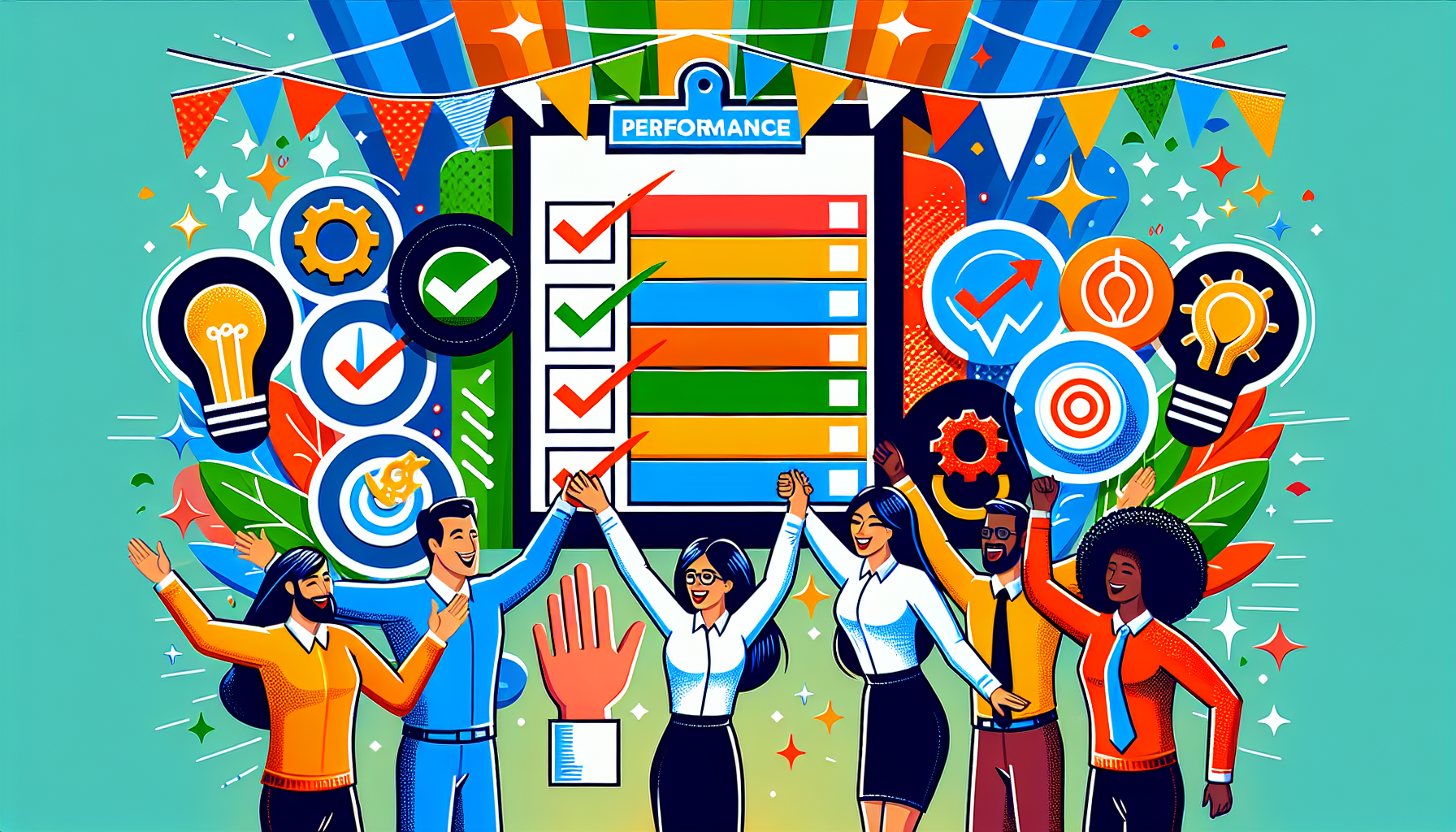Struggling to set clear and effective goals for your team? We’ve got you covered. This article provides employee goal setting examples that boost productivity, enhance professional growth, and align individual objectives with company goals. Discover actionable goals for performance, development, and more.
Key Takeaways
-
Employee goal setting enhances engagement and aligns personal objectives with organizational goals, boosting motivation by up to 22%.
-
The SMART framework ensures goals are specific, measurable, achievable, relevant, and time-bound, facilitating clarity and focus.
-
Recognizing and rewarding goal achievement significantly increases employee satisfaction and motivation, creating a positive workplace culture.
Understanding Employee Goal Setting

Employee goal setting helps individuals and teams reach their full potential. When employees set their own goals, they feel ownership and commitment, leading to higher engagement and motivation. This involvement connects them to the company mission, promoting transparency and alignment with organizational objectives. It also enhances job satisfaction and retention by making employees feel valued and integral to the company’s success.
Encouraging employees to set their own goals leads to proactive behavior and a more dynamic workplace culture. It alters their self-perception, making them feel more connected and responsible for outcomes. Aligning individual goals with the company mission boosts productivity and increases motivation by up to 22%.
Organizations with a lower power distance involve employees in goal setting, enhancing their motivation and commitment.
Examples of Performance Goals for Employees

Performance goals serve as strategic objectives, directing employees in fulfilling their roles and contributing to the company’s success. These goals vary widely depending on job responsibilities and broader company objectives. Clear performance goals help employees focus their efforts, leading to improved performance and job satisfaction.
Here are some specific examples of employee performance goals that can help employees excel in their roles.
Increase Sales Revenue
Increasing sales revenue is a critical performance goal for employees in sales. This can be achieved by boosting revenue by 15% over the next quarter through targeted marketing campaigns and customer outreach. Specific goals might include making more sales calls per week or enhancing follow-up procedures with leads.
Using the SMART framework ensures that these goals are Specific, Measurable, Achievable, Relevant, and Time-bound. Regular check-ins can help monitor progress and provide constructive feedback.
Enhance Customer Satisfaction
Enhancing customer satisfaction is another vital performance goal. Clear goals, such as improving service quality through staff training and better communication, can significantly impact overall business performance.
Feedback systems like surveys and customer reviews gather valuable insights and address customer needs more effectively. Streamlining service processes to meet customer expectations is also crucial for maintaining a competitive edge.
Improve Team Collaboration
Improving team collaboration fosters a positive work environment and enhances overall productivity. Collaboration goals can improve team dynamics, communication, and trust among team members while aligning with team goals. For instance, participating in team-building activities like Lunch & Learn sessions and coffee chats strengthens bonds and improves cooperation.
Collaboration goals also influence personal motivation and resilience while decreasing work-induced tiredness. Companies that promote collaboration are five times more likely to perform at a high level. Encouraging open communication and providing constructive feedback are crucial for enhancing teamwork and productivity.
The benefits of setting these goals include improved productivity, higher job satisfaction, and a more positive work environment.
Personal Development Goals for Professional Growth

Personal development goals maintain motivation and guide career direction. These goals help employees enhance their skills and contribute to their professional growth, benefiting the organization. Setting professional and personal goals provides clarity regarding expectations and improves productivity.
Here are some specific types of personal development goals that can drive career growth and professional development while enhancing job satisfaction.
Develop Leadership Skills
Developing leadership skills is crucial for personal and professional growth. Employees who take on leadership roles are better equipped to handle more responsibility and lead teams effectively. Leadership workshops provide practical tools and techniques to enhance management skills and build confidence.
Taking on a mentorship role allows employees to guide others, fostering collaboration and improving team dynamics. Continuous personal development in leadership keeps skills relevant and prepares employees for future challenges in their careers.
Enhance Technical Skills
Enhancing technical skills is essential for personal and professional growth. Specific goals, such as completing an advanced course in relevant software or technology within the next six months, help employees focus on necessary skill improvements.
Regularly evaluating progress towards these goals ensures adaptability and sustained growth.
Improve Communication Skills
Effective communication is crucial for successful collaboration and team alignment with organizational goals. Training in communication skills can significantly impact performance and cooperation. An example goal might be to participate in training sessions and practice active listening techniques during team meetings.
Enhancing communication skills leads to improved relationships, better conflict resolution, and increased employee satisfaction. These improvements benefit individuals and contribute to a more cohesive and productive team environment.
Self-Management Goals for Better Productivity

Self-management goals involve taking ownership of tasks, managing deadlines, and showing self-awareness, which are crucial for enhanced productivity. Practicing these skills boosts productivity, improves performance, and helps achieve goals.
Here are some specific self-management goals that can lead to better productivity and overall success.
Time Management
Time management is a critical self-management skill that improves productivity. Creating and following a daily schedule to prioritize tasks and meet deadlines can significantly reduce procrastination and enhance task completion rates.
Consistency in adhering to a daily schedule improves the ability to manage workloads efficiently.
Task Prioritization
Prioritizing tasks is essential for effective self-management and productivity. By identifying the most critical tasks and focusing on them first, employees can make the best use of their time and resources. This approach helps in achieving performance goals and maintaining high productivity.
Stress Management
Effective stress management is crucial for maintaining high productivity levels in the workplace. Incorporating stress-relief practices like regular breaks and mindfulness exercises contributes to sustained productivity. These techniques enhance employee well-being and lead to better performance outcomes.
Regular use of stress-relief techniques improves mental health and increases job satisfaction. Managing stress effectively allows employees to maintain high performance and contribute positively to the organization’s success.
Innovative and Creative Goals
Innovation and creativity goals are essential for driving growth and keeping organizations competitive. These goals help employees develop new ideas, products, or processes that can significantly impact the company’s success.
Here are some specific innovative and creative goals that can foster a culture of innovation within the workplace.
Generate New Ideas
Encouraging employees to propose multiple solutions stimulates creative thinking and fosters a culture of creativity in the workplace. For instance, adopting a more efficient way to run meetings.
Setting a goal to contribute at least one innovative idea during the quarterly performance review is a measurable way to track progress.
Participate in Innovation Workshops
Innovation workshops help employees stay updated on industry trends and bring fresh perspectives to the team. Regularly attending these workshops enhances creativity and collaboration within teams.
A goal might be to attend a training workshop and conference every month.
Setting SMART Goals for Clear Objectives
The SMART framework is a powerful tool for setting clear and attainable objectives.
SMART stands for:
-
Specific
-
Measurable
-
Achievable
-
Relevant
-
Time-based
These criteria ensure that goals are well-defined and aligned with organizational objectives and broader objectives, making it easier for employees to understand and achieve their targets.
Here is a breakdown of each component of SMART goals and how they contribute to effective goal setting.
Specific Goals
Specific goals are clear and detailed, ensuring that employees know exactly what they are working towards. For example, instead of “improve customer service,” a specific goal would be “reduce customer complaint response time to under 24 hours.” This clarity helps employees focus their efforts and understand expectations.
Measurable outcomes establish clear metrics to evaluate progress and success. Achievable targets ensure that measurable goals are realistic and attainable, considering available resources. Relevant objectives align individual goals with broader organizational goals, ensuring efforts contribute to overall success.
Time-bound deadlines create urgency and focus, promoting timely completion of goals.
Measurable Outcomes
Clear metrics allow for tracking progress and measuring the success of goals. For instance, a measurable goal might be “increase website traffic by 10% over the next quarter.” This provides a concrete target to aim for and a way to measure success.
Achievable Targets
Goals need to be realistic and attainable, considering available resources and constraints. Setting achievable targets ensures that employees are not overwhelmed and can realistically meet their goals.
For example, “complete a project within two weeks” might be achievable if necessary resources and time are available.
Relevant Objectives
Employee goal setting aligns individual objectives with broader organizational goals. Relevant goals ensure that employees contribute to the organization’s overall success. Applying the SMART criteria helps create clear objectives that align with the company’s broader strategies.
Regular feedback refines goals and ensures they remain relevant to changing organizational objectives.
Time-Bound Deadlines
Establishing a timeframe for goals creates urgency and maintains focus on completion. Deadlines for performance goals enhance motivation and focus.
For example, “complete a training course by the end of the month” provides a clear deadline to work towards.
Tracking Progress and Providing Feedback
Tracking progress and providing feedback are critical components of achieving performance goals. Monitoring employee progress ensures alignment with organizational objectives and enables timely feedback. This process identifies areas for improvement and acknowledges small achievements, boosting morale and motivation.
Here are some effective methods for tracking progress and providing feedback.
Regular Check-ins
Consistent individual meetings help maintain focus on critical tasks and prompt necessary adjustments. Gathering feedback from various sources provides a well-rounded perspective on employee performance. Regular check-ins are essential for monitoring progress and addressing challenges.
Utilize Goal Tracking Software
Goal tracking systems can visualize team performance and highlight areas needing improvement. Utilizing goal tracking software plays a vital role in monitoring and managing the progress of employee goals. By having a clear view of progress, managers can offer more structured feedback and support.
Constructive Feedback
Timely and specific feedback is crucial for guiding employees towards achieving their goals effectively. Scheduling regular one-on-one meetings can help discuss progress and address any challenges faced by employees. Implementing goal tracking software can assist in monitoring progress and providing more structured feedback.
Providing constructive feedback helps employees understand their strengths and areas for improvement. Highlighting achievements in public forums fosters a culture of appreciation and can enhance job satisfaction. Publicly recognizing accomplishments can enhance team camaraderie and a sense of belonging among employees.
Recognizing and Rewarding Goal Achievement

Recognizing and rewarding goal achievement significantly boosts employee motivation and performance improvement. 83% of employees report higher happiness when recognized for achieving their goals. Workers who feel appreciated tend to have higher job satisfaction.
Showing appreciation and recognizing accomplishments are top contributors to employee engagement and motivation. Let’s explore some effective ways to recognize and reward goal achievement.
Celebrate Milestones
Celebrating milestones throughout the goal-setting journey reinforces motivation and fosters a sense of accomplishment among employees. Offering tangible incentives, such as bonuses or extra time off, can motivate employees to achieve significant goals.
Publicly recognizing achievements in team meetings or through company newsletters boosts morale and encourages continued effort.
Offer Incentives
Offering incentives can significantly boost employee motivation and enhance overall job satisfaction. Tangible rewards, like bonuses or extra time off, can be highly effective for encouraging employees to meet and exceed their goals. Celebrating milestones along the way can help maintain momentum and provide ongoing motivation for employees.
Public recognition of achievements in team meetings or company newsletters fosters a culture of appreciation and further motivates employees.
Public Recognition
Public recognition of employee achievements significantly boosts morale and motivation across the team. During team meetings, managers can highlight specific achievements to encourage a culture of recognition and foster teamwork.
Company newsletters can feature individual and team accomplishments, ensuring that employee contributions are celebrated organization-wide.
Summary
In summary, effective employee goal setting is crucial for aligning individual ambitions with organizational objectives. By setting clear, attainable goals, providing regular feedback, and recognizing achievements, organizations can foster a motivated and engaged workforce. Implementing SMART goals ensures that objectives are specific, measurable, achievable, relevant, and time-bound, leading to better performance and job satisfaction. As you embark on your goal-setting journey, remember that the key to success lies in continuous improvement and celebrating every milestone along the way.
Frequently Asked Questions
What are SMART goals?
SMART goals are a powerful way to structure your ambitions, ensuring they are Specific, Measurable, Achievable, Relevant, and Time-based. By defining your goals this way, you set yourself up for success and clarity in your journey!
How can I improve team collaboration through goal setting?
Improving team collaboration through goal setting is essential; set clear collaboration goals, engage in team-building activities, and encourage open communication to enhance dynamics and productivity. Embrace these strategies, and watch your team thrive together!
Why is it important to regularly check in on employee progress?
Regularly checking in on employee progress is crucial because it helps keep them focused, addresses any challenges, and offers timely feedback, ensuring they successfully reach their goals. Stay proactive for a thriving team!
How can stress management practices improve employee performance?
Stress management practices can significantly boost employee performance by promoting well-being through regular breaks and mindfulness exercises. Embracing these techniques not only reduces stress but also empowers individuals to excel in their roles.
What role does public recognition play in employee motivation?
Public recognition significantly boosts employee motivation by enhancing morale, fostering appreciation, and promoting teamwork. When people feel valued, they are inspired to give their best!






